
I was chatting to Sarah from our running club while we were warming up before the start of our half marathon this past Sunday. She expressed her preference for doing her training all out on the trail. The problem is that nobody else in her village is into trail running and she doesn’t want to run in remote areas on her own.
“What about Kyra your three-year-old Hungarian Vizsla? Surely she will be a perfect running buddy for you. She’s super protective, full of energy and always available.” was my instant response.
How to trail run with a dog? Remember that even the most athletic dog breeds cannot manage heat as well as us. Be sure your dog stays hydrated. Gradually increase your dog’s trail run distance and ensure a good warm-up walk before, and warm-down walk after each run.
Just like what Sarah will be doing with Kyra, there is a process of introducing your new four-legged furry running buddy to the trails. There are a number of factors that you need to bear in mind to ensure that you have a trail buddy for life.
1. Walk Before You Run
The cliche of needing to learn to walk before you can run certainly holds true here.
Before you can even think of running with your dog both on-leash and especially off leash, be sure to train your dog to walk at heel by your side.
The other factor is that you need to introduce running in a gradual manner too. Start the running component with run/walk intervals of one minute run and one minute walk.
These intervals serve two purposes. Firstly, it is a progressive adaptation to the activity of steady pace running. Dogs naturally run in very short sprints and then will stop for a sniff break to recover. Secondly, As you start running the first couple of times your dog will tend to bolt the way they normally run and will likely pull you. Those walk breaks will give you the chance to bring your dog back under full control.
2. Select A Dog That Is A Great Runner
This may come as a surprise to some. While it is true that all dogs have the ability to run, there are some breeds that are not biomechanically suited for the activity of running. Doing so will only result in painful injuries for your dog that will likely need even more painful surgeries down the line.
Two breeds that come to mind here are Pugs and Bulldogs. A less obvious addition to the non-runner list will be German Shepards with their predisposition to hip dysplasia. Other breeds that tend to develop joint problems when running long over rough trail conditions are Golden Retrievers, Boxers, Beagles,
My English Springer Spaniel, Bubpke was a was a wonderful running partner. No end to his energy levels, he loved the trails and he was very easily trainable. As a longer haired breed and living in a warm climate meant choosing the right the time of day for our runs. His method of heat regulation was jumping into streams, ponds and muddy puddles. This lead to near-constant battles with ear infections.
My top dog breed choices for trail running are:
- Hungarian Vizsla: The Vizsla is an astounding athlete. They can go short distances very fast, but also have amazing endurance. Vizslas are superb trail runners, jumping over obstacles with ease. They can navigate and type of terrain and are super trainable. If you get one of these super athletes, be prepared to rack up a long run streak. Once a Vizsla is fully fit it has the type of energy that needs 60 minutes or more of running, seven days a week.
- Weimaraner: They are tough on rough trails and are pretty fearless. They can run long and can sprint just as easily. Their short hair helps them keep cool in warm climates.
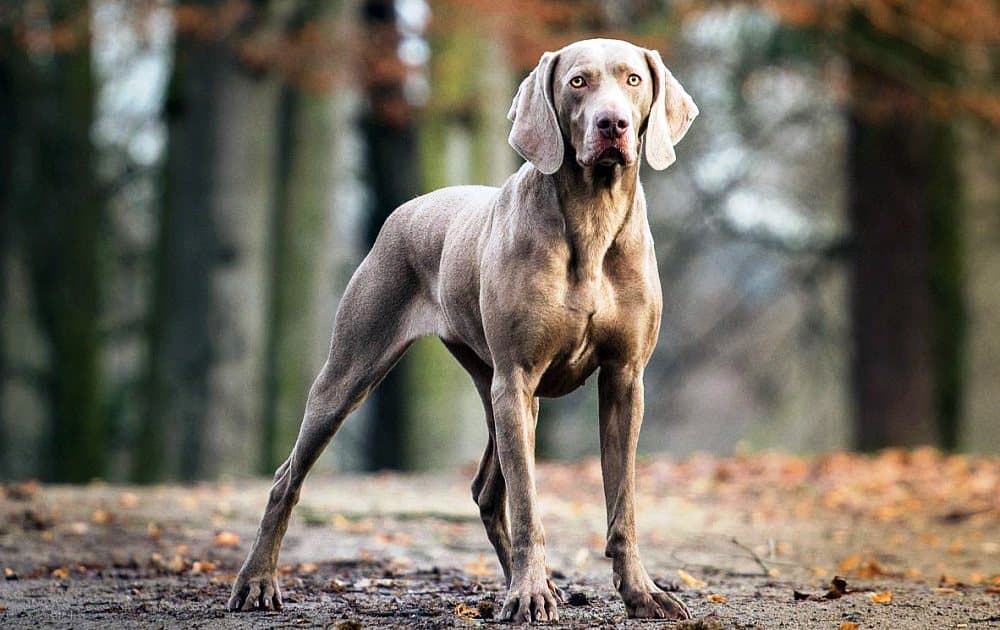
- Border Collie: A minority of Border Collies are born with carpal (wrist) issues that will lead to arthritis in later life, so best to get that checked out. If your Border Collie has avoided that, then good luck to you trying to keep up. Border Collies can go forever at a pace that will challenge elite-level runners. I had a Border Collie / Labrador Retriever crossbreed in high school when I ran middle-distance on the track. Anything further 800m I had no chance of keeping up, and in the 800m it was only my sprint at the end that was faster than my dog.
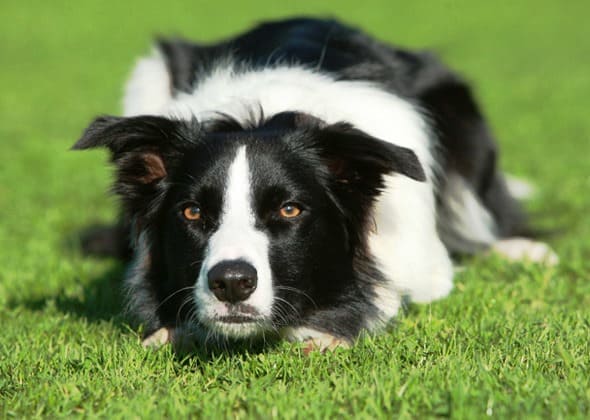
- German Shorthaired Pointer: The German Shorthaired Pointer or GSP for short is an amazing endurance athlete. That said, don’t for a moment think that these dogs are slow. On long runs, the GSP is the master of the negative split as they tend to get stronger the longer the run goes. Over shorter distances of up to five miles, the GSP easily keeps pace with cyclists. The GSP is very smart and consequently easily trainable. Some GSPs have anxiety issues, though this has been linked to boredom. When they are well trained and well exercised their anxiety disappears. The GSP is sure-footed with lightning reaction speed making them even better on trails than on the road. Together with the Vizsla, I rank the GSP as an equal top choice dog breed for running trails.
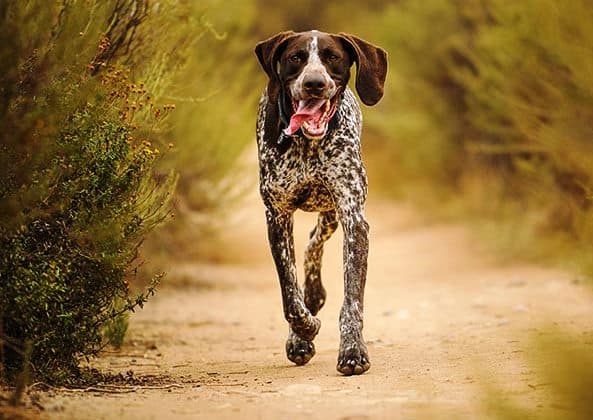
- Rhodesian Ridgeback: The Rhodesian Ridgeback has a long, efficient stride. This gives the Rhodesian Ridgeback great endurance. These tough dogs were originally bred to hunt lions in Africa. Their short, low maintenance coat is well suited to hotter climates. I have read in some forums about the Rhodesian Ridgeback being “snappy” and aggressive. This is more to do with idiot owners keeping their high energy, intelligent dogs enclosed in small spaces. A lack of training and exercise makes the Rhodesian Ridgeback highly frustrated.
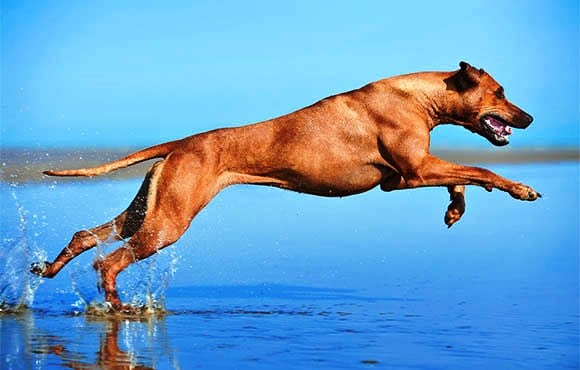
- Australian Kelpie: If you are looking for a small breed dog as a running partner, look no further than the Australian Kelpie. The Kelpie is super loyal and tough as nails. I read a report about a runner that did a 2h23 Boston marathon whose Kelpie was on every single training run for the six months leading up to the race.
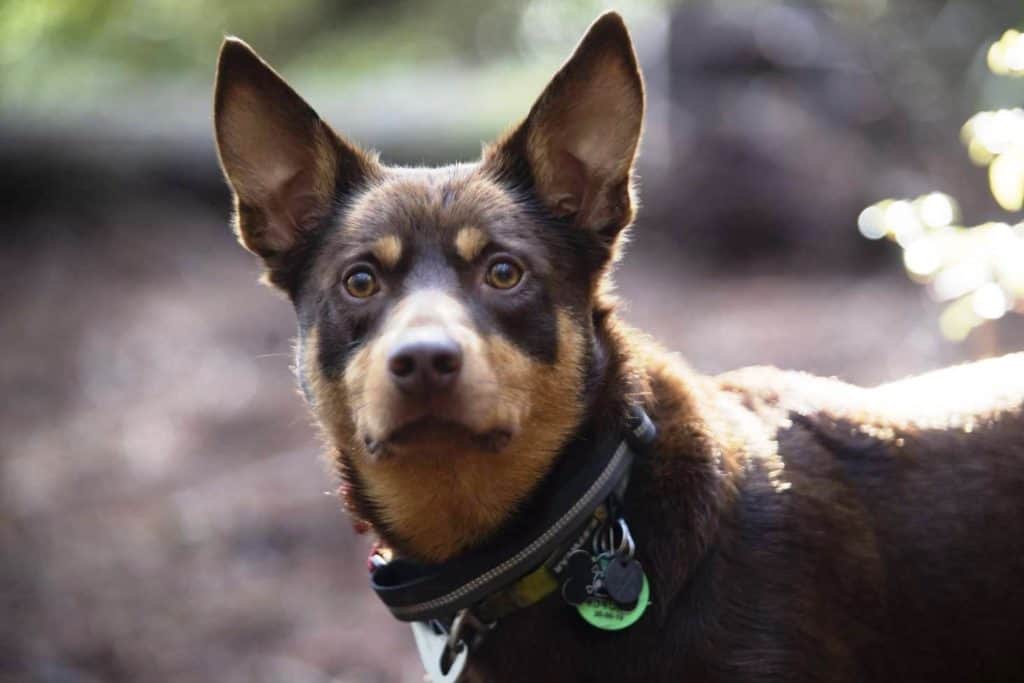
- Dalmatian: Dalmatians can be excellent runners in they are kept in good shape. Their short, light-colored coat is great for temperature control. Dalmatians tend to run with a much heavier footstrike than the above-listed breeds. For this reason please keep your Dalmatian on softer trails and away from paved roads if at all possible.
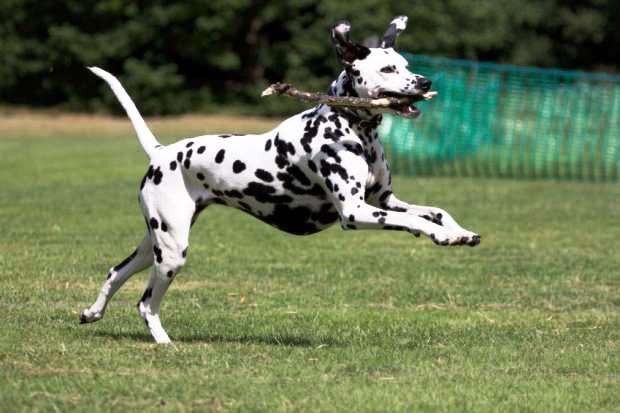
- Siberian Husky: As the name suggests, the Siberian Husky was bred for very cold climates. I have heard it described that keeping a Siberian Husky in a hot climate as idiotic and at times even cruel. They have a thick coat designed to keep them warm outside during the Siberian winter. Nobody can dispute that these popular dogs can run all day long. If you live in a warmer climate and have a Siberian Husky, please have it groomed regularly. Sure, your Husky will look a little strange after a haircut. However, when it comes to keeping cool, your Husky isn’t overly vain so therefore neither should you.
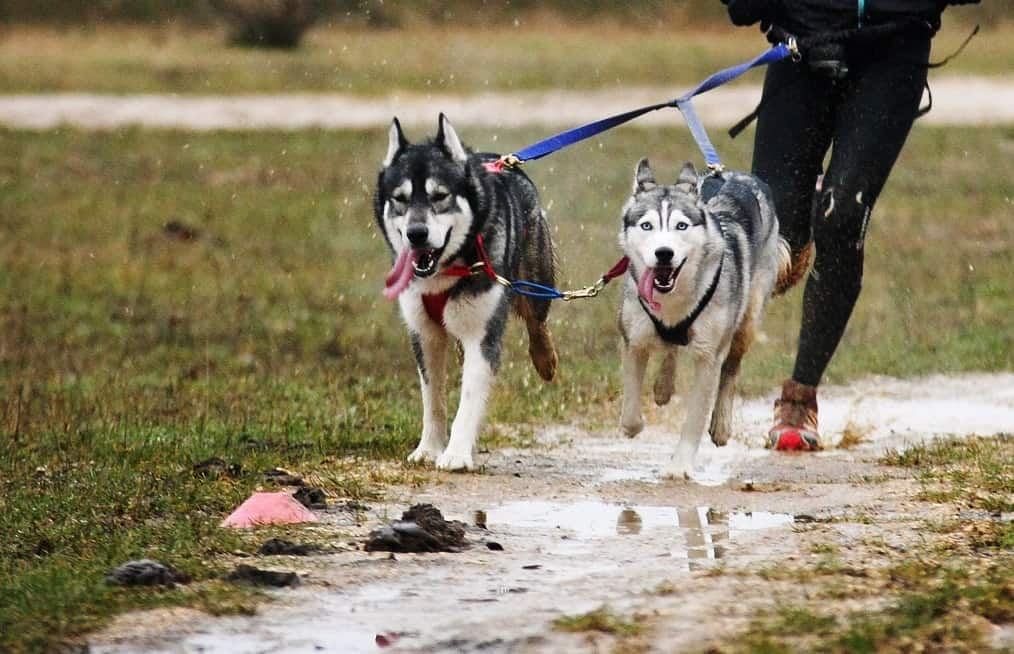
3. Talk To Your Vet
Before you start up any running program for your dog it will always be a good idea to have your dog checked thoroughly by your vet. When you do, be sure to tell your vet that you are intending to make your dog your run buddy and what your weekly or daily mileage is.
That information will allow your vet to check your dog’s weight, fitness level, and joint health against data about your dog’s specific breed.
Once analyzed your vet will give you recommendations about what level of running your dog can handle now. Your vet will also give you advice about what level of running your dog can build up to and over what period of time.
For the sake of preventing your beloved dog getting painful injuries, please heed the advice from your vet.
4. Don’t Start Too Young
I have seen many blogs and vlogs that indicate that the best age to start running with your dog is as soon as it is a year old. That, to my mind, is a bad idea. Let me explain why.
All of the dog training that I have done over the years involving leash commands that progress to hand commands all start when the dog is no younger than 18 months.
Starting to run with your dog at the age of 1 year means that you start the running program six months before you can start effective leash training.
This will result in your dog developing the habit of dragging you on the leash. It is a habit that your dog will associate with running even after you have trained your dog to walk properly to heel on a leash.
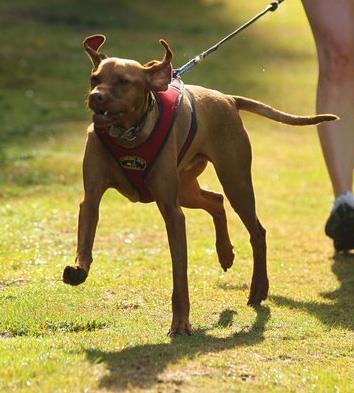
5. Start On A Leash
It is vital that you start by training your dog on a leash. The first order of business will be to train your dog to walk to heel on a leash.
An interesting side note was something that I learned in dog training class back in high school that I attended with my Border Collie. It was more “people training” for me as my dog’s previous owners had trained him already.
What I was taught back then was to ensure that I always kept my dog to my left when he was walking to heel. This positioning places me as the “top dog” within the relationship. When people that start walking with their dog to their right establish the hierarchy with the dog as pack leader and their dog will consequently tend to pull forward.
I had a friend who had two Staffordshire Bull Terriers that had been “impossible to train” their entire lives. Yet by putting them to my left, they were both walking to heel on loose leashes inside a minute.
As I mentioned, start by training your dog to walk to heel. I start with a short leash, then progress to looser and looser leashes. Eventually, the dog will walk to heel off leash and a simple tap of my left thigh with my hand will bring the dog to heel.
Once you have walking to heel off leash sorted, you can move to recall. The recall command is basically that you want your dog to come to you whenever you call them. Again start with your dog on-leash for the recall training as being on-leash is associated with being under your direct control.
Even though it is totally fine to walk with your dog out on the trails during training, keep your dog on a leash and keep to wider fire trails where it is physically possible to walk to heel at all times.
I have done extensive research into the best possible hands-free leash and dog harness combination I could find. Both are rated 4.5 stars on Amazon with over 4600 customer reviews between them. Here are the links to the Amazon customer review pages so that you can see for yourself what hundreds of other customers have to say:
- RUFFWEAR All Day Adventure Harness For Dogs (Reviews Page)
- Tuff Mutt Hands-Free Dog Leash For Runners (Reviews Page)
6. Begin More Slowly
It is a bad idea when you are helping a newbie human runner to take them on a 10 mile run at your race pace for their first run. At best it will be too hard for their enjoyment level and at worst will likely injure them. The same applies when running with your dog.
Start on leash on those same fire trails where you were walking and bring in some running intervals with one minute run followed by one minute walk. Build up till your dog can manage five minutes of running with a one-minute walk break. Once you have reached the five-minute mark you can start to reduce the walk break time. Be sure to start and end each outing with five minutes of walking as warm up and warm down.
This is not only building your dog’s ability to run but also stay running to heel. The moment your dog pulls ahead of you the fun stops and the next walk break starts. If your dog has a lot of energy it may take a couple of outings till you are able to manage a full minute of running to heel without pulling ahead.
When you can manage a five mile run with your dog to heel the entire way you will be ready to move on to running off-leash. This might sound counter-intuitive, but do not make your first off-leash runs on the same wide trails that you were running on-leash. Instead, choose the narrowest single track that you can safely run.
Make your dog sit behind you on the narrow trail then start running with a command like “come”. The moment your dog overtakes you, and it will because it can likely run faster than you, the fun stops immediately. Stop on the trail and recall your dog. Once your dog is recalled and sitting behind you, start the process again.
There will be times when you will need to put your dog back on a leash along a single track like when you encounter other trail users. You will want your dog immediately behind you and not 300 yards up the trail ahead of you. Keeping your dog behind you on single tracks maintains your position as pack leader while out on runs.
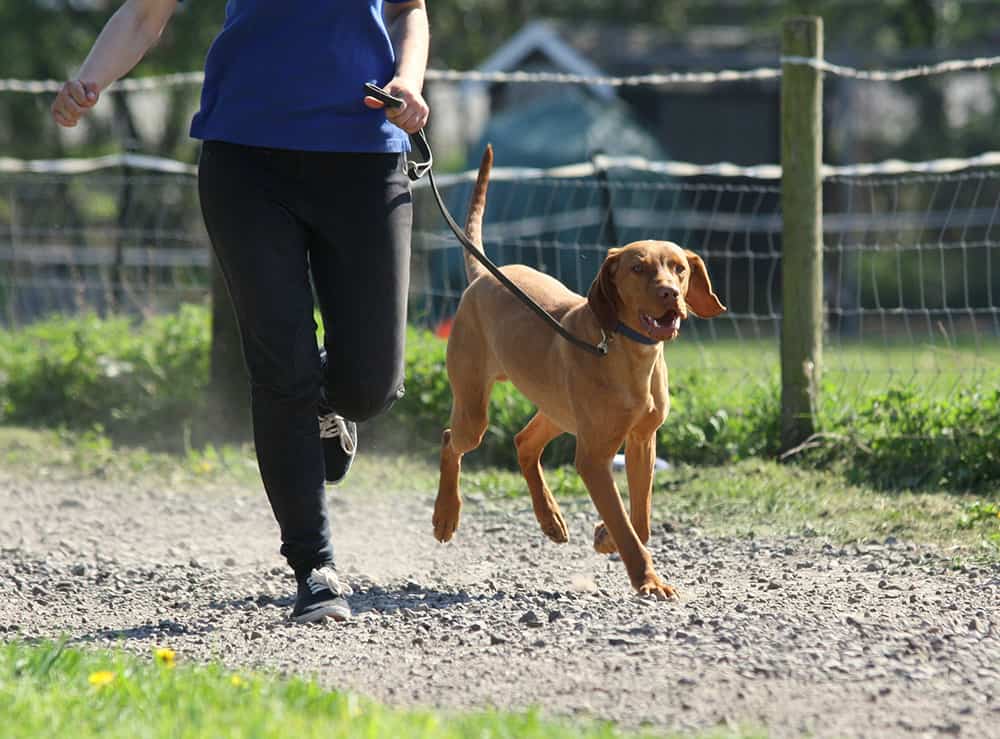
7. Stay Alert During Your Run
Be aware of signs that your dog is getting tired. The only way for your dog to regulate temperature is through its tongue.
Excessive panting means that it is time for a walk break. If necessary have a complete rest stop before walking again, slowly easing back into a jog.
Be aware of the moment your dog starts limping. Nine times out of ten it will be a small stone, twig or burr caught between the pads of a paw.
Running with your dog is more about enjoying time with your dog than your running goals. The well-being of your dog is more important than any STRAVA segment.
Another factor that requires awareness is to keep your running to established trails where you and your dog have reasonable sight of the trail surface ahead of you. I would never run my dog across an ankle-deep grassy meadow as the risk of my dog stepping into a rabbit hole or mole hole at full pace is simply too great.
8. Keep Your Dog Hydrated
Hydration is massively important for your dog. The way I see it dogs have lower relative mass and blood volume, therefore, are prone to getting dehydrated faster than we do.
Using my Camelbak has become second nature. So much so that grabbing my drink tube for a sip mid-run is second nature. If you are the same then you will need to do as I do, plan regular dog hydration stops.
Back when I had a dog that I ran with, I’d use my Camelbak for my hydration and pack a couple of Solomon soft flasks for my dog.
What I would do is plan water stops for my dog at the top of hills. I based that choice on my own experience. When I am pushing myself hard uphill to the point where I feel my pulse thumping in my head and my legs are just about at the point of collapse, the last thing I can imagine is filling my belly with water without wretching.
It is much easier to keep water down as I start easing downhill and my heart rate eases back a bit. I can only imagine that if that strategy works the best for me that it will work for my dog as well.
Whatever you do, please keep your dog’s bottle to plain water. Gatorade and other sports drinks have been formulated for the human digestive system. The most likely scenario of giving your dog Gatorade is that your dog will become very ill from gastrointestinal distress and vomiting will cause even more dehydration out on the trail. It is both the carbohydrates and the electrolytes that mess up their digestion.
The good news is that your dog is able to absorb water into their system more easily than you can. As a result, your dog will fully rehydrate very quickly.
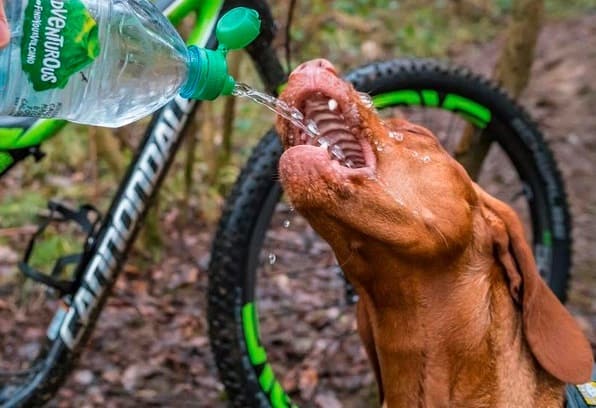
9. Fueling Strategy for Trail Running Dogs
Dogs have a completely different fueling system than we do when they run. A higher density of mitochondria within their muscles means that fat burning is their primary fueling source when running. So please do not share your energy bar or gel. The most likely outcome will be your dog emptying their intestines soon afterward, most of the time with zero warning of the imminent disaster.
With this in mind, what nutrition changes will you need for your newly athletic dog? The vast majority of dogs are nowhere near as active as they ought to be and consequently are in the overweight to obese range. I often see people take their dog on a leisurely two-mile walk then reward their dog with treats like big milky bones. The trouble with that is the treat has more calories than what was burned on the walk.
If you are jogging with your dog for about 20 minutes at a time three or four times a week then there is no need for anything over and above your dog’s normal food. Most normal, commercial, dog food has around 15% to 16% calories from fat.
When you get to the point where you are running with your dog for 30 minutes or more, seven days a week, then you have the option of upgrading to a high-performance dog food that has a 20% or higher fat composition. During the transition phase to a higher fat composition food, you can add a teaspoon of good olive oil over your dog’s regular food on long run days. Each teaspoon of olive oil boosts the fat of that meal by between 1% and 2%.
Something else to remember is that fat is less digestible. This usually leads to a higher volume of fecal mass, so it would be best if you pack extra plastic bags for your long runs.
On the subject of protein, this is vital for your dog. In order to build and maintain muscle your dog’s nutrition plan should be 25% protein as an absolute bare minimum.
Remember that your dog is a canine and its nutrition plan should reflect that. I remember reading one study that indicated that dogs fed a diet of plant-based soy protein had a significantly higher rate of musculoskeletal injuries than those who ate meat protein.
10. Choose Trails With Your Dog in Mind
To a large extent, this comes down to thinking about your dog’s strengths and limitations.
The shattered shards of freeze/thaw granite that you get on many high altitude trails will shred your dog’s paws to bits. Likewise, thorny paths of trails lined with Chestnut trees will be a painful experience for your dog.
If you have a dog that will chase and attack anything that moves, do not go into areas where rattlesnakes are particularly active.
For the most part soft to firm packed trails with flowing corners and even a bit of leaf litter will be just perfect for all dogs.
Choose your time of day based on temperatures and how susceptible your dog is to heat fatigue.
11. Clean Up After Your Dog
Nobody enjoys stepping around piles of dog excrement out on the trails. However, this is a much more serious matter than simple courtesy and trail etiquette.
A large proportion of the wonderful trails that we run on are within nature parks of some form or another. Access to these areas is not a guaranteed right under the constitution or any law.
Always remember that the agencies that are tasked with protecting these often fragile natural environments do not have you and your dog as their priority. Access to these areas is a privilege and not a right.
Leaving mess out on the trail can easily lead to access to your favorite trail getting revoked. Not only for you but for all trail dogs or potentially all trail runners.
It is something that I have seen happening over and over again within the realm of rock climbing due to the localized high impact areas at the bases of rock climbing routes leading to climbing band within nature parks the world over. There is no reason to indicate that this will not happen within the realm of trail running as well.
12. Carry A Whistle
When I went out into the mountains with my English Springer Spaniel I would always take a whistle with me. Mine would be one of those sporting referee whistles on a red lanyard that I could wear around my neck. Having a whistle with you is sound practice for mountain safety.
I trained my dog to react to the sound of my whistle as a recall command. This is very useful when you are near a waterfall and you need something that will carry over the sound of the waterfall. There were occasions in the mountains where someone else would whistle and my dog would immediately run to me. I would always praise my dog for obeying the recall command even if I had not given the command.
There is also a whistle app for your phone that is a useful backup in case your whistle gets lost or buried at the bottom of your Camelbak. However, I will never replace a physical whistle with just using the app.
Physical whistles don’t need battery power. Besides that, I have this tendency to trip over things. If I don’t trip over things then my feet work just as well for me to trip over when I get fatigued. There is always a chance that I will smash a phone when I trip and fall. To date, however, I have never broken my metal referee whistle in any of my faceplant falls.
13. Ensure That Your Dog Has ID
This is vital anytime you and your dog venture out, whether out in nature or a simple walk around the block. Attached to your dog’s collar should be a tag that has your dog’s name, your name, as well as your phone number.
An engraved metal tag will always be better as the tag will be able to withstand getting wet and not degrade from sunlight as plastics do.
I would attach two tags to my dog’s collar, though not both to the same loop of the collar. That way if one tag gets snagged on something and lost out on the trail you will have a backup.
It is also sound practice to get a microchip for your dog. In many countries, a microchip is mandated by law if your dog is outside of your property at any time.
I have also read in the regulations of many nature parks that dogs are required to have identification.
I remember the first time I took my English Springer Spaniel into the mountains. It was in an enclosed valley with a dry river bed and cliffs at the head of the valley and on both sides. It was late afternoon, not the wisest time of day in hindsight. My dog spotted a small animal, I forget now what it was, and bolted after it.
Calling and blowing my whistle yielded no results at all. I searched for my dog for over two hours. By the time I stopped the sun had set and there was barely enough twilight left for me to make my way back down the valley, feeling distraught. I got back to my car and there was my dog, sitting patiently beside the front passenger side door, waiting to go home for supper.
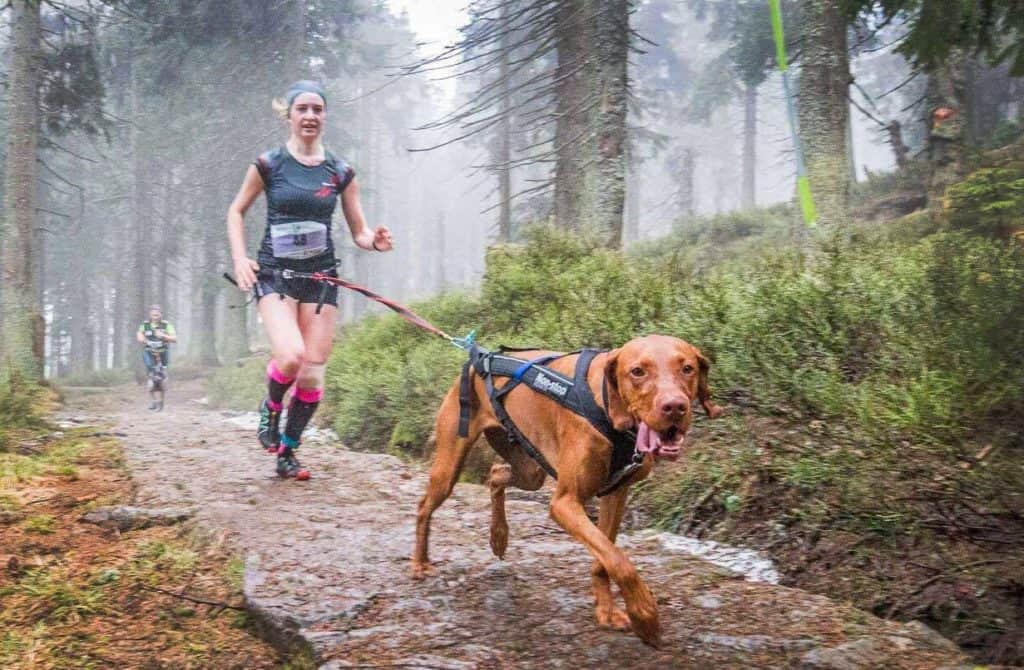
14. Take Care After Each Run
At the end of every run be sure to check your dog thoroughly for any cuts and scratches. Pay particular attention to paws and the areas between pads of paws.
Another very important aspect of post-run care for your dog will be checking for ticks. Even if your dog has been washed and dipped with tick repellent products that same morning you can never be too careful with those critters.
I have always used a fine tooth wire grooming brush after each and every trail run with my dog. These are great for brushing all ticks out of the dog’s fur and trapping them before the ticks have a chance to attach. Once I have finished with the grooming brush I will always run my hands over the dog’s entire coat to check for any ticks that may have attached.
In my experience, most ticks tend to be around the front shoulders, chest, neck, and ears so pay particular attention to those areas. In peak tick season I have removed well over two dozen ticks after a single half hour run.
15. The New and Growing Sport of Canicross
Canicross is a relatively new European based sport that has evolved from the offseason training that owners did for their Mushing (sledding) dogs.
The original off-season sled dog training involved Dog Scootering where the dogs pulled an unmotorised kick scooter. This soon morphed into Bikejoring where the dogs would pull a mountain bike. Canicross is the version of this where a sled dog would be pulling a runner around cross-country trails. These would invariably be the same trails, though thawed, that were used for Mushing during winter.
There is a second theory that Canicross evolved independently from Skijorking because these two activities are so similar. Considering that Skijorking has its own origins in Mushing, the original point of origin is the same.
Because Canicross was originally limited to sled dogs, only Huskies and Malamutes were permitted in Canicross events. However, as Canicross gained popularity as a stand-alone sport across southern European countries where the weather is a lot warmer other dog breeds have been added to the permitted lists.
These days almost all dog breeds are permitted at Canicross events. It must be stated that longer endurance events do exclude breeds of dog that are not genetically suited to the terrain or distance.
Not only can almost all dog breeds compete in shorter Canicross events, but also people of all ages and abilities. That includes the visually impaired and children. The idea is to encourage people to get outside and be physically active with their dogs and meet other like-minded people.
There are two aspects about Canicross that I see as substantially different to “normal” trail running with your dog. First is that the Canicross dog always runs out front and pulls the runner along at a rapid pace in the same way as a sled dog will pull a sled. The second flows from the first in that being dragged by your dog’s leash can be painful to your lower back over time. For this reason, the leash is replaced by a Bungee cord or elastic line.
Canicross as a stand-alone sport developed and spread quickly through Europe in the early 2000s. About a decade later it spread across to the US where it is known as CaniXC or CaniX. In the US CaniX is still very localized to the areas where Mushing is a winter activity. In Europe, Canicross events have spread all the way south to the deserts of Andalucia so there is no reason to think that the same kind of expansion won’t happen in the USA.
Related Questions
Is it OK to run with your dog? Generally speaking, it is totally OK to run with your dog. There are some breeds of dog that are not suited for running so it is best to consult your vet before starting to run with your dog. Remember to start slowly like you would with any newbie runner.
When can you start running with a dog? Many websites and vets suggest not running with your dog till after they are a year old so that their muscular-skeletal system can cope with the load. While this is true, dogs respond best to training commands beyond the age of 18 months.
How often should dogs run? All of the dog breeds that are capable of running can cope with three runs per week. If you have one of the super-athlete dogs like the Vizsla, German Shorthaired Pointer or Weimaraner be prepared to be running seven days a week.
How do I train my dog to run without a leash? You train your dog to run off leash in three steps. Train your dog to run to heel on a leash. Then train your dog to recall on command. Finally, make your first off-leash runs on narrow single track keeping your dog behind you. Stop every time your dog passes you and restart with your dog behind you.
